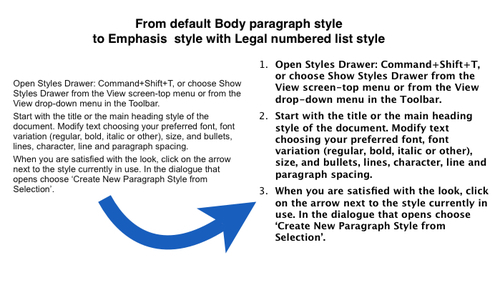We express house or company style through trademarks and logos or brand colors and images. But we also need to have a distinct style in our text documents. This includes a consistent use of fonts, line and paragraph spacing, and lists and bullets.
The iWork tools allow us to create a selection of text styles. This recipe shows how to do this. Once styles have been created, we can change our text to house style with one click.
Create a document that includes a title, headings for chapters, articles, sections and subheadings for smaller pieces of text and captions, as well as words or groups of words that you want to highlight within the text. Next, create a consistent style for all of them.
The following steps show how to create a consistent text style for all your company literature. Follow them when creating a periodic publication, such as a newsletter or magazine.
- Open Styles Drawer by pressing Command + Shift + T, or by choosing Show Styles Drawer from the View screen-top menu or from the View drop-down menu in the toolbar.
- Start with the title or the main heading style of the document. Modify the text by choosing your preferred font, font variation (regular, bold, italic, or other), size, and bullet, character, line, and paragraph spacing.
- When you are satisfied with the look, click on the arrow next to the style that is currently in use. A dialog will open. Choose Create New Paragraph Style from Selection...:

- In the next dialog, type the name of the new style—for example, Magazine main heading—over the highlighted default style name.
- Repeat steps 2 to 4 for each element of the document's formatting, from the title to the main body of text.
- Repeat steps 2 to 4 for character styles and for list styles, if you use any.
- Next time you open the document, all the styles will be in the Styles Drawer. Click anywhere on the text and then click on the required style. It will change all its attributes, as defined in your saved house style.
Your new styles can be modified later. First make the new changes you want in your text. To save these changes into your house styles, look in the Styles Drawer. You will see that the black arrow against the style you are using has turned red. Click on the arrow, and the previously grayed-out options Redefine Style from Selection and Revert to Defined Style will be accessible. Choose Redefine Style from Selection to save the changes you've made.
Paragraph styles keep attributes of paragraphs, such as font, size, text color, character and line spacing, shadows and background colors, and indentation and tabs. Paragraph styles are useful for quick formatting of headings, main text, callouts and captions, and also for headers and footers.
Character styles are mostly to emphasize certain words or lines of text within a paragraph. These styles include font variations, for example, italics. When you apply a character style to the selected text, a word or group of words for example, only this part of the text changes. This is useful, for instance, when you want the title of a book or the name of an organization to stand out within your main text.
List styles include indentation and style of numbering and bullets. If you have used custom image bullets, they will also be saved.
The following screenshot shows how the appearance of text can quickly be changed by applying a style:

Don't rush to create styles, and don't create too many. Make sure you have achieved the desired look before saving styles, otherwise it is easy to lose track of which style you use for what purpose. When you open a new document in iWork, it already has a set of styles in the Styles Drawer. Modify them gradually or create new ones, using the Style Drawer tools.
Create a distinct style and follow it throughout the document. Usually, no more than one or two fonts should be used. This gives the impression of a distinct, consistent style. If too many different fonts and variations are used, and too many different colors are applied, it creates an untidy, messy look.
For a large project with graphic images and charts, choose a font family with a large selection of variations, so that you can use one font but different variations. Besides the usual regular, bold, and italic, you could also choose semi-bold, light, condensed, black, and so on.
To create another document by using this same house style, you can duplicate your original (Command + D), then change the name of the copy, and type your new text over it. Or, once you are satisfied with your created style, you can save the document as a template.
- Chapter 2, Working with Text
- The Using the color picker to create a custom color palette recipe in Chapter 10, Designing from Scratch: Beyond Templates
